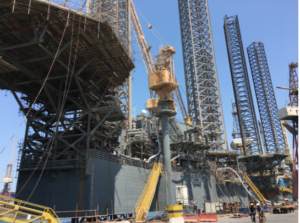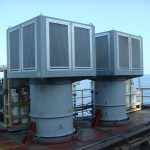According to IHS data, there are 35 more mobile offshore drilling units (MODU) working this week compared to one year ago. This is good news for the offshore drilling industry that has suffered though the longest downturn in history. However, there are still over 125 MODUs looking for work. A considerable amount of work will be needed in  readying idle rigs to return to work because they have been sitting idle for an extended period. A critical part of a MODU’s recommissioning process will be to ensure that the ventilation systems are fully functional. Eldridge has developed an equipment inspection checklist as part of a complete ventilation system inspection to prepare MODUs for operations.
readying idle rigs to return to work because they have been sitting idle for an extended period. A critical part of a MODU’s recommissioning process will be to ensure that the ventilation systems are fully functional. Eldridge has developed an equipment inspection checklist as part of a complete ventilation system inspection to prepare MODUs for operations.
Regardless of the preservation process used on a MODU while it was idle, a full inspection of all ventilation systems is a necessity. Eldridge’s equipment inspection checklist instills customer confidence of reactivated vessels performance.
Safety First
- Personnel Safety takes priority, therefore learn the owner’s safety policies
- Understand the emergency signals, escape routes, and muster areas
- Prior to inspecting any ventilation equipment, follow proper lockout/tagout procedures for your job scope
Documentation
- Review the existing ventilation documentation and equipment list (if possible)
- Record any changes of ventilation equipment during inspection that may not have been properly updated on the rig owner’s documentation
- Question and record the reasons the changes occurred (if changes are found)
 Hoods, Deck Openings, Ductwork
Hoods, Deck Openings, Ductwork
- Visually inspect air intake and exhaust hoods for debris and corrosion
- Rundown the Ductwork routes and visually inspect for corrosion
- Visually inspect Safety Screens are installed where applicable and verify the integrity of the material
- Verify weather/watertight covers/lids have adequate seal when closed (if equipped)
- Verify screw-down lids and hand-wheels rotate adequately (if equipped)
Supply and Exhaust Fans
-
- Open fan access panels and perform a visual inspection of the inside of the fan housing looking for debris, obstructions or corrosion (if equipped)
- Safely spin the fan impeller to determine if it spins freely
- Add fresh grease to any fan that has greaseable bearings
- Meg the motors to determine motor integrity
- Test the connections in the motor junction box to determine adequacy of the connections and feed from breakers at the MCC and determine any grounding issues.
- Restore power to fan motors following all Safety Procedures
- Bump fan briefly with power and listen for any unusual noises such as motor bearing squeal or propeller rubbing, and verify the fan propeller is spinning
- Fully start the fan and observe any unusual noise or vibration and verify proper direction of airflow
- Inspection of the fan start/stop control panel for proper operation will be provided in steps 6 & 7
- Test the full load amps to ensure the motor(s) are performing within the motor tolerances with all fans running for an enclosed area (i.e. engine room)
Fire Dampers/Critical Dampers
- Power off fans to visually inspect the inside of the damper for debris or obstructions that will prohibit the damper from properly closing and sealing
- Inspect linkages for any damage or corrosion
- Restore power to damper and observe that it has fully opened
- Cycle the dampers and verify proper operation
- Return the damper to the fully closed position and visually inspect proper sealing
- Verify the Damper Control Panel is functioning properly
- Coordinate with Fire Control System, Electrical, and Instrumentation Groups to verify that communications to fire dampers are functioning properly and report/record any anomalies in damper components needing to be replace
Eldridge’s checklist provides a thorough reporting/recording method of the existing ventilation system to determine the adequacy or modifications required to deliver a safe and successful operating vessel.
Capital equipment replacements, changes or upgrades of various other types of rig equipment is commonly an additional scope necessary for rig re-activation. It is important to fully understand the scope of work, which may require additional ventilation design assessment, calculations, and fluid flow analysis for proper ventilation and safe working pressure.
Whether your MODU needs a readiness inspection or a complete ventilation system analysis, Eldridge’s experienced group can get your rig ventilation systems back to operational status.
